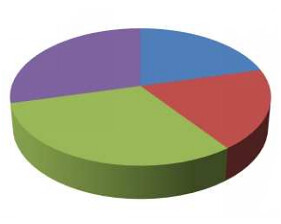In the United States, building codes govern the planning, design, construction and often operation of our buildings. Codes encompass sets of regulatory data that specify the minimum standards by which we must construct our building and non-building structures. The International Building Code (IBC) is widely used in the United States. It reflects a set of rules on how we should build and what type of techniques, materials and processes we should follow. The result is a safe and permitted structure. The IBC, however, does little to regulate building behavior with regard to disaster resilience and climate change adaption.
Disaster Resilience and climate change adaptation strategies are often implemented by choice from available disaster mitigation programs. These programs are categorically divided into voluntary and mandatory programs. Most, however, are voluntary. Elective programs encourage owners and communities to implement design choice that can reduce the risk of damage from natural disasters while mandatory programs seek to enforce and enhance standards through law. In the same way that governments adopt model codes as law (e.g. the IBC), mandatory mitigation programs provide language for state and local government and Federal Agencies to adopt as law with the objective of reducing losses from natural hazards. HPBRS (High Performance Building Requirements for Sustainability) is a mandatory program ready for adoption. Often such requirements are formatted to facilitate adoption as amendments to the current IBC. Still, such mandatory amendments need to be adopted by local and state officials for progress to be made. And even when done so, the increased disaster resistance and improved durability are considered enhanced sustainability requirements within such amendments.
Disaster mitigation programs for adoption are technically either prescriptive-based or performance-based. The simplest approach is prescriptive, where one specifies how to build using rules that engage the engineer with what the design must achieve, avoid and/or eliminate. Prescriptive guidelines are built upon assumptions about the nature of the hazard, the structural response, and the design objectives. Design professionals must carefully evaluate these assumptions again the objectives of the project before proceeding. Performance-based approaches state what the final results need to be and how it will be measured. It does not specify how those results are to be achieved. Such approaches can be achieved through probabilistic assessments of hazards and consequential damage whereby a cost-benefit analysis to balance increased costs with improved structural resistance is provided. The probabilistic process can be repeated to achieve varying levels of robustness. This can help optimize the balance between additional materials required for construction and probable savings from repairs during the facility’s lifetime. Despite superiority of the performance-based approaches, many of the programs discussed are prescriptive. They are relatively simple and therefore have greater likelihood of being adopted by owners and government agencies.
Much is happening to incorporate disaster resilience design strategies into standards and codes. Engineers continue to encourage the use of LEED and life-cycle assessment. A performance-based design standard for fire protection is to be published as a joint venture through the Fire Protection Committee of ASCE/SEI and NFPA. The AISC Design Guide 19 for fire design is also available. Other developments in FP can be found in ASCE/SEI/SFPE 29-05 Standard Calculation Methods for Structural Fire Protection 2005 and ACI 216.1-07 Code Requirements for Determining Fire Resistance of Concrete and Masonry Construction Assemblies, July 2007.
Established in 1969, the National Institute of Standards and Technology (NIST) Engineering Laboratory has for many years supported numerous national programs with the ultimate aim of identifying improvements in codes, standards, and practices. NIST supports the adoption of disaster risk management in the code and is currently funding researching in following topics:
-
Application of Database-assisted Design within the framework of the wind tunnel methods.
- Risk Targeted Earthquake to replace the Maximum Considered Earthquake in an effort to make risk the common denominator in design, instead of hazard.
- Structural load improvements.
- Methods for estimating wind speeds based on the logarithmic law long.
- Use of Saffir-Simpson hurricane scale for design wind speeds; database assisted design; and wind directionality effects.
- In conjunction with NRC, criteria on hurricane-borne missile speeds.
- Guidelines for including manufacturing into LCA.
Seismic events and weather-related disasters effect developed and developing countries, with much devastation faced by the rapidly growing low-income and lower middle-income countries (WBG, 2014). A lack of code compliancy along with failure to address issue of building and land-use regulatory policy in developing countries has lead to rapid urbanization without regard to disaster risk. The Global Facility for Disaster Reduction and Recovery (GFDRR), a World Bank-managed fund supported by 21 donor partners, the European Union, the World Bank, and the United Nations, is aiding in the provision of advanced knowledge and advice on disaster risk management. During the 2012-2013 fiscal year, GFDRR helped over 80 developing countries to better identify, prepare for, and recover from natural disasters (WBG, 2015). Assistance is provided across five areas: 1) risk identification; 2) risk reduction; 3) disaster preparedness; 4) financial protection for countries and people; and 5) resilient recovery when disaster does strike. The GFDRR aims to conventionalize disaster risk management and recovery into all country development polices and plans. A huge step towards this goal is the commitment of the International Development Association (IDA) to review all country strategies and operations for climate and disaster risks. (WBG, 2015).
Spending time and money up front to reduce the likelihood of loss during a natural disaster can bring significant benefits to owners and communities. These benefits are many and include lowering insurance costs, raising property values, providing security to residents, maintaining a consistent tax base, and minimizing the cost of disaster response and recovery. No community can ever be completely safe from all hazards, but resiliency planning gives communities the knowledge and abilities to protect themselves before and mend themselves after a disaster. Structural engineers and our supporting organizations play a vital role in resilient communities. As the nation moves forward to incorporate disaster resiliency as a national priority, standards organizations will be expected to play a critical and complementary role in achieving that goal.
References
Rodriguez-Nikl,
T., Comber, M., Foo, S., Gimbert-Carter, S., Koklanos, P., Lemay, L., Maclise,
L., VanGeem, M., and Webster, M. (2015). “Disaster Resilience and
Sustainability”, SEI Sustainability Committee, Disaster Resilience Working
Group, http://tiny.cc/DisResSust.
"Standards and Codes:
Disaster-Resilient Structures and Communities." NIST. NIST Engineering
Laboratory, 11 Jan. 2011. Web. 20 Oct. 2015.
“Improving Building Code Implementation
and Compliance for More Resilient Buildings in Developing Coutnries:
Considerations for Policy Makers.” The World Bank, October, 2014. Web.
21 Sept. 2015.
"Helping Countries Better Prepare for
and Manage Disaster Risks, Climate Change." The World Bank, 30
January 2014. Web. 17 Sept. 2015.














